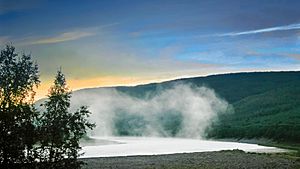Tana River (Norway) facts for kids
The Tana River (known as Teno or Tenojoki in Finnish, and Tanaelva in Norwegian) is a long river, about 361 kilometers (224 miles) in length. It flows through the northern parts of Norway (in Finnmark county) and Finland (in the Lapland region). The local Sámi people call it the "Great River," which shows how important it is to them. The Tana River is special because it is one of the most important rivers in the world for Atlantic salmon to lay their eggs and reproduce.
Contents
What is the Tana River?
The Tana River forms a natural border between Norway and Finland for much of its length. It starts where two other rivers, the Anarjohka and Karasjohka, meet. From there, it flows northwards and eventually empties into the Barents Sea, which is part of the Arctic Ocean.
Where is the Tana River located?
The Tana River is found in the northern part of Scandinavia, a region in Europe. It runs through the cold and beautiful landscapes of Sápmi, which is the traditional land of the Sámi people. This area is known for its vast wilderness, including forests, fells (small mountains), and many lakes.
The River's Journey
The river's journey begins in the high fells and plateaus. As it flows, it carves a path through deep valleys and wide plains. The landscape around the Tana River changes with the seasons, from snowy winters to bright, green summers with the Midnight Sun.
Why is the Tana River important for salmon?
The Tana River is famous worldwide for its large population of Atlantic salmon. These fish are born in the river, travel to the ocean to grow, and then return to the same river to lay their eggs. The Tana River provides perfect conditions for salmon reproduction.
The Salmon Life Cycle
Atlantic salmon have a fascinating life cycle. They hatch from eggs in the river's gravel beds. Young salmon, called parr, live in the river for a few years. Then, they become smolts and migrate to the Atlantic Ocean. After several years at sea, growing large and strong, they return to the Tana River to spawn (lay eggs). This journey can be thousands of kilometers long.
Fishing on the Tana River
Because of the many salmon, fishing has been a very important activity on the Tana River for hundreds of years. Both the Sámi people and others living in the area rely on the salmon for food and income. Fishing is carefully managed to make sure there are enough salmon for the future. Rules are in place to protect the fish and their habitat.
People of the Tana River
The Tana River area is home to the Sámi people, who are the indigenous people of northern Scandinavia. They have lived along the river for centuries and have a deep connection to its waters and the surrounding land.
Sámi Culture and the River
The Tana River is central to Sámi culture and traditions. It has provided food, transportation, and a way of life for generations. Many Sámi families still live by the river and continue traditional practices like fishing and reindeer herding. The river is not just a natural feature; it is a vital part of their identity and heritage.
Protecting the Tana River
Because the Tana River is so important for salmon and the local people, there are many efforts to protect it. Both Norway and Finland work together to manage the river's resources and keep its environment healthy.
Conservation Efforts
Conservation efforts focus on keeping the water clean, protecting the salmon's spawning grounds, and managing fishing sustainably. This ensures that the Tana River remains a healthy home for salmon and continues to support the communities that depend on it.
See also
 In Spanish: Río Tana (Noruega-Finlandia) para niños
In Spanish: Río Tana (Noruega-Finlandia) para niños


